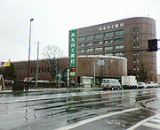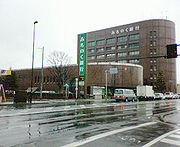
Michinoku Bank
Encyclopedia

Bank
A bank is a financial institution that serves as a financial intermediary. The term "bank" may refer to one of several related types of entities:...
that is headquartered in Aomori
Aomori, Aomori
is the capital city of Aomori Prefecture, in the northern Tōhoku region of Japan. As of 2009, the city had an estimated population of 302,068 and a density of 366 persons per km². Its total area was 824.52 km².- History :...
, Aomori Prefecture
Aomori Prefecture
is a prefecture of Japan located in the Tōhoku Region. The capital is the city of Aomori.- History :Until the Meiji Restoration, the area of Aomori prefecture was known as Mutsu Province....
. The name “Michinoku” is distinctive in that it was the first use of hiragana
Hiragana
is a Japanese syllabary, one basic component of the Japanese writing system, along with katakana, kanji, and the Latin alphabet . Hiragana and katakana are both kana systems, in which each character represents one mora...
in the name of a Japanese bank. Michonoku Bank, while focused on the Tōhoku region
Tohoku region
The is a geographical area of Japan. The region occupies the northeastern portion of Honshu, the largest island of Japan. The region consists of six prefectures : Akita, Aomori, Fukushima, Iwate, Miyagi and Yamagata....
, has a network of branches and subsidiary companies that expands beyond the region. In Japan, Michinoku has offices in Hokkaidō
Hokkaido
, formerly known as Ezo, Yezo, Yeso, or Yesso, is Japan's second largest island; it is also the largest and northernmost of Japan's 47 prefectural-level subdivisions. The Tsugaru Strait separates Hokkaido from Honshu, although the two islands are connected by the underwater railway Seikan Tunnel...
, Akita
Akita Prefecture
is a prefecture of Japan located in the Tōhoku Region of northern Honshu, the main island of Japan. The capital is the city of Akita.- History :The area of Akita has been created from the ancient provinces of Dewa and Mutsu....
, Iwate
Iwate Prefecture
is the second largest prefecture of Japan after Hokkaido. It is located in the Tōhoku region of Honshū island and contains the island's easternmost point. The capital is Morioka. Iwate has the lowest population density of any prefecture outside Hokkaido...
, Miyagi
Miyagi Prefecture
is a prefecture of Japan in the Tōhoku Region on Honshu island. The capital is Sendai.- History :Miyagi Prefecture was formerly part of the province of Mutsu. Mutsu Province, on northern Honshu, was one of the last provinces to be formed as land was taken from the indigenous Emishi, and became the...
, and Saitama Prefecture
Saitama Prefecture
is a prefecture of Japan located in the Kantō region of the island of Honshu. The capital is the city of Saitama.This prefecture is part of the Greater Tokyo Area, and most of Saitama's cities can be described as suburbs of Tokyo, to which a large amount of residents commute each day.- History...
s, as well as a branch in Tokyo
Tokyo
, ; officially , is one of the 47 prefectures of Japan. Tokyo is the capital of Japan, the center of the Greater Tokyo Area, and the largest metropolitan area of Japan. It is the seat of the Japanese government and the Imperial Palace, and the home of the Japanese Imperial Family...
. Outside of Japan, Michinoku has established Michinoku Finance (Hong Kong) Ltd in Hong Kong
Hong Kong
Hong Kong is one of two Special Administrative Regions of the People's Republic of China , the other being Macau. A city-state situated on China's south coast and enclosed by the Pearl River Delta and South China Sea, it is renowned for its expansive skyline and deep natural harbour...
, established representative offices in Wuhan
Wuhan
Wuhan is the capital of Hubei province, People's Republic of China, and is the most populous city in Central China. It lies at the east of the Jianghan Plain, and the intersection of the middle reaches of the Yangtze and Han rivers...
and Shanghai
Shanghai
Shanghai is the largest city by population in China and the largest city proper in the world. It is one of the four province-level municipalities in the People's Republic of China, with a total population of over 23 million as of 2010...
, China, and has opened three branches throughout Russia
Russia
Russia or , officially known as both Russia and the Russian Federation , is a country in northern Eurasia. It is a federal semi-presidential republic, comprising 83 federal subjects...
in Moscow
Moscow
Moscow is the capital, the most populous city, and the most populous federal subject of Russia. The city is a major political, economic, cultural, scientific, religious, financial, educational, and transportation centre of Russia and the continent...
, Khabarovsk
Khabarovsk
Khabarovsk is the largest city and the administrative center of Khabarovsk Krai, Russia. It is located some from the Chinese border. It is the second largest city in the Russian Far East, after Vladivostok. The city became the administrative center of the Far Eastern Federal District of Russia...
, and Yuzhno-Sakhalinsk
Yuzhno-Sakhalinsk
-Demographics:Most residents are ethnic Russians, but there also exists a sizable population of Koreans. Of the 43,000 Sakhalin Koreans, half are estimated to live in Yuzhno-Sakhalinsk, comprising roughly 12% of the city's population...
, through a subsidiary corporation, The Michonoku Bank (Moscow), though expansion into Russia has met with some controversy.
Profile
As of March 31, 2005- Assets: approximately 1.8 trillion yen (approximately USD 16.3 billion)
- Employees: 1,212 (excluding subsidiary corporations)
- Branches: 111 (87 in Aomori Prefecture, 21 outside of Aomori, 3 in Russia)
- President: Yasuo Sugimoto
- Member: Regional Banks Association of Japan
History
The current Michinoku Bank can trace its origins to 1894, when the Aomori Shogyo Bank was established. In 1976, Seiwa Bank, the successor to the Aomori Shogyo Bank, merged with the Hirosaki Sogo Bank to form the current Michinoku Bank. In January 1980, Michinoku adopted the use of Tom and JerryTom and Jerry
Tom and Jerry are the cat and mouse cartoon characters that were evolved starting in 1939.Tom and Jerry also may refer to:Cartoon works featuring the cat and mouse so named:* The Tom and Jerry Show...
as mascots for the bank. These mascots were used until 2004, when the bank decided to stop using the characters in order to rehabilitate its image as the “Tom and Jerry Bank.” In 1995, Michinoku opened a representative office in Yuzhno-Sakhalin, and four years later established a subsidiary in Moscow.
Points of interest
Kappei Ina, a local radio talk show host, allegedly claimed that when customers withdrew money at Michinoku automatic teller machines (ATMs), the display did not display the honorificHonorific
An honorific is a word or expression with connotations conveying esteem or respect when used in addressing or referring to a person. Sometimes, the term is used not quite correctly to refer to an honorary title...
suffix “-sama” that is often used with a company’s customers. However, the ATMs used this suffix when customers deposited money. Ina speculated that the reason for this was that those customers that deposited money into the bank were true customers, while those who withdrew money were not customers. One week after this was aired, the Michinoku ATMs displayed the honorific “-sama” suffix.
Michinoku Bank was the bank that was used in the “Anita Scandal.” This scandal involved a Japanese businessman for the Aomori Prefectural Public Housing Corporation who was arrested for funneling funds in excess of 13 million US dollars to his Chilean wife, Anita Alvadoro. Some of this money was used to build a lavish house in Chile
Chile
Chile ,officially the Republic of Chile , is a country in South America occupying a long, narrow coastal strip between the Andes mountains to the east and the Pacific Ocean to the west. It borders Peru to the north, Bolivia to the northeast, Argentina to the east, and the Drake Passage in the far...
.
In April 2005, Michinoku came under fire for losing information over an estimated 1.3 million customers. This prompted a response from the Japanese Financial Services Agency that Michinoku reform its business practices. In May, the company’s long serving president, Kosaburo Daidōji, left the company. Daidōji died on July 21, 2005 at the age of 80.
Russian Business Expansion
One distinctive feature of Michinoku is its expansion into the Russian financial market. This has been said to be one legacy from former president Kosaburo Daidōji. Daidōji was said to have developed an interest in Russia after hearing from his father, who had studied in EuropeEurope
Europe is, by convention, one of the world's seven continents. Comprising the westernmost peninsula of Eurasia, Europe is generally 'divided' from Asia to its east by the watershed divides of the Ural and Caucasus Mountains, the Ural River, the Caspian and Black Seas, and the waterways connecting...
, say that Russians were different from other Europeans in that they did not discriminate against Japanese.
Daidōji had eyed the Russian market since the collapse of the Soviet Union, and finally established the subsidiary on July 7, 1999, becoming the first subsidiary of a Japanese bank to open in Russia. Following this, Michinoku opened a branch in Yuzhno-Sakhalinsk on August 12, 2002, and then a branch in Khabarovsk
Khabarovsk
Khabarovsk is the largest city and the administrative center of Khabarovsk Krai, Russia. It is located some from the Chinese border. It is the second largest city in the Russian Far East, after Vladivostok. The city became the administrative center of the Far Eastern Federal District of Russia...
on July 7, 2003. Presently, the Russian operations are said to have a scale of around 10 billion yen and around 7,300 personal accounts, including an account held by Russian pop group t.A.T.u.
T.A.T.u.
t.A.T.u. was a duo formed in Moscow, Russia in 1999 by Ivan Shapovalov. The group consisted of Lena Katina and Yulia Volkova.Their debut single "Ya Soshla S Uma" was released in December 2000. The single had a huge success in Russia and Eastern Europe...
There is some controversy behind this move, however. When Daidōji first initiated the Russian operations, he said that he did not expect to turn profits for 5–10 years. Industry experts and former employees have criticized this move, claiming that “while the reason for the expansion was that the market in the prefecture was saturated, it was a really risky move,” and “the expansion of business into Russia has come at the expense of the development of the firm.” While the Russian subsidiary claimed a 240 million yen in pretax profits in December 2004, Michinoku injected 2.1 billion yen of capital into the subsidiary in August of that year. One former employee said that Michinoku was using capital injections to eliminate the losses by the subsidiary.

